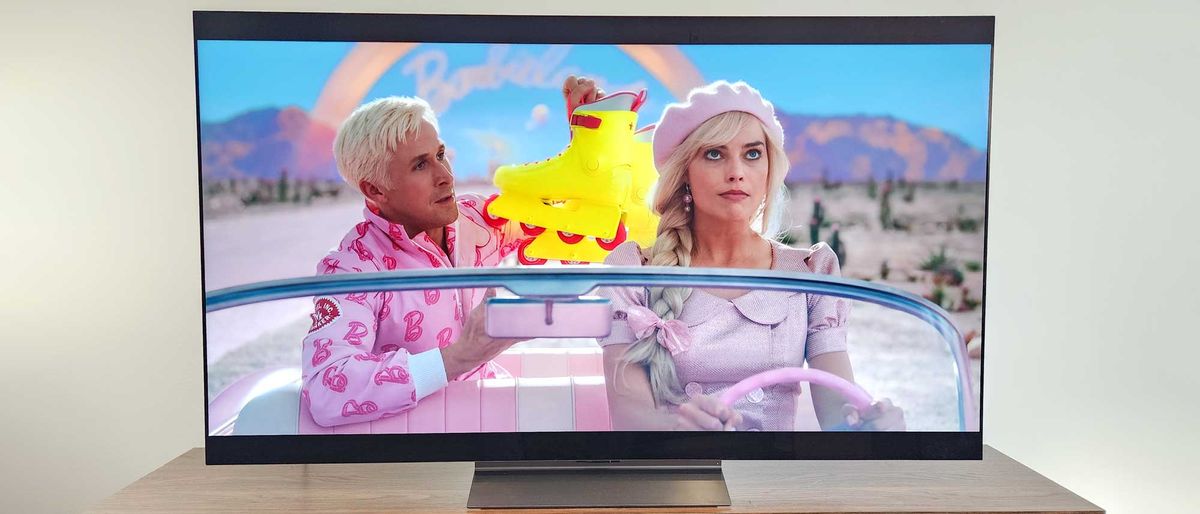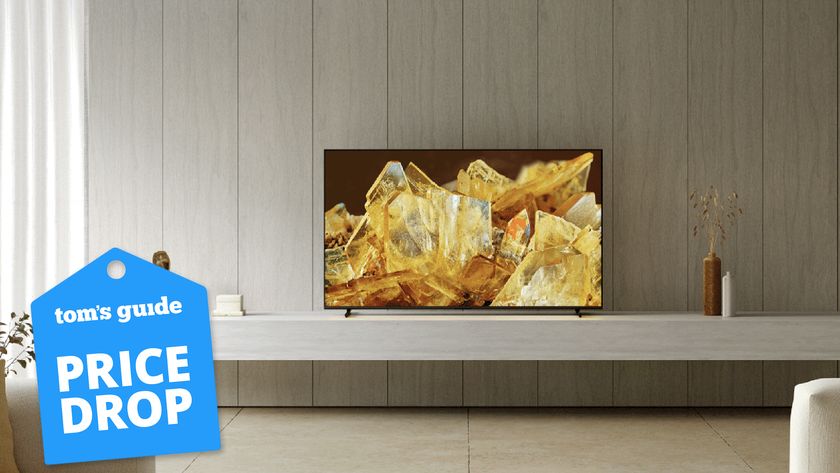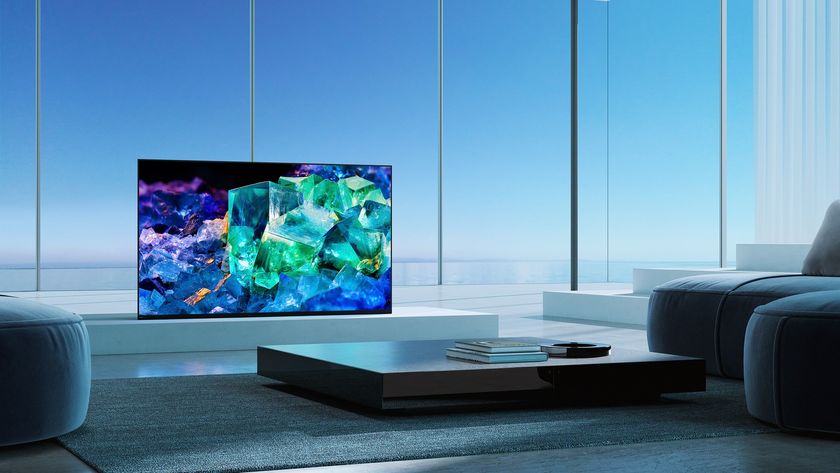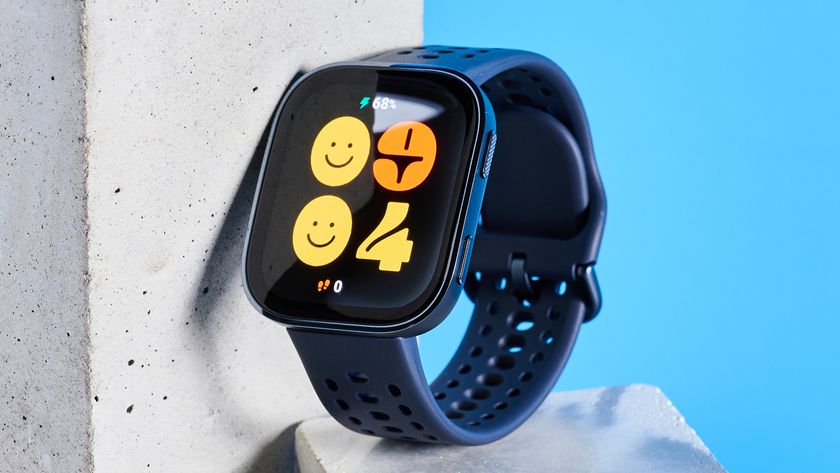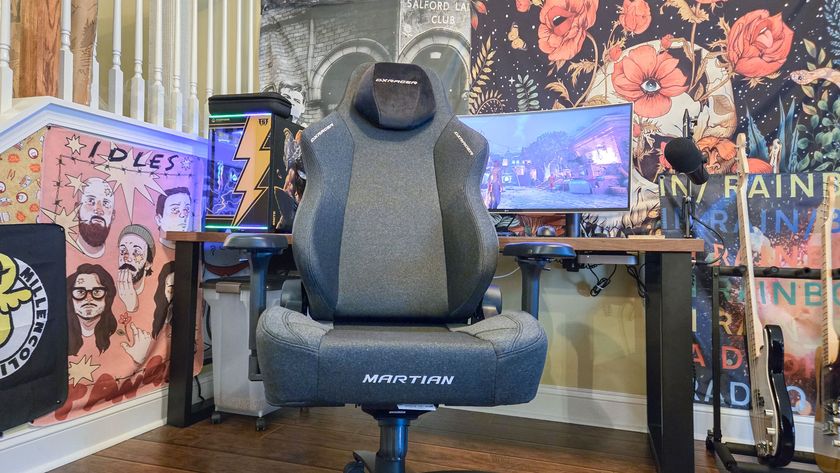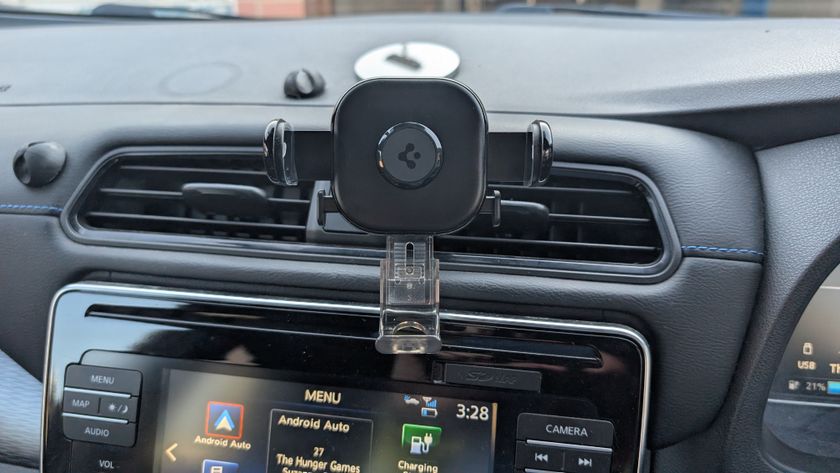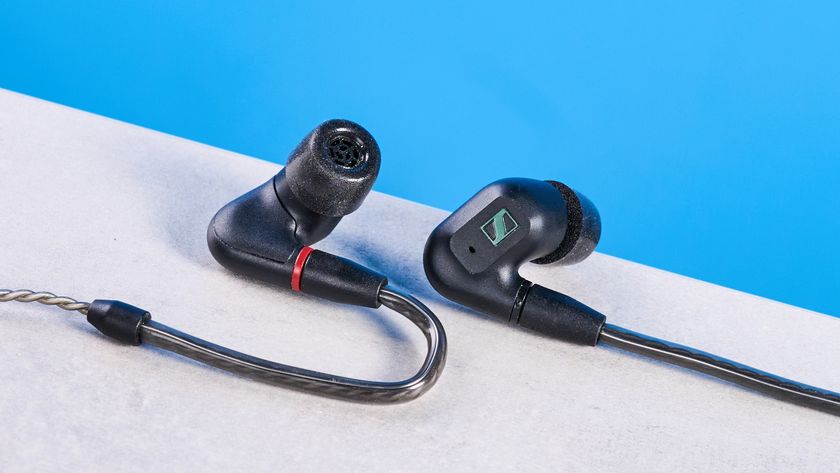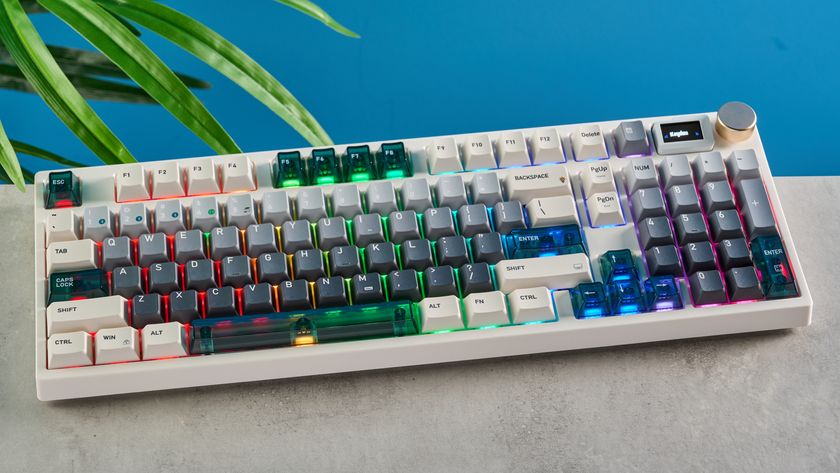Tom's Guide Verdict
The LG C4 OLED TV is a real winner in most categories thanks to stunning picture quality, game performance and features. But small issues, like its unexciting sound, and tough competition from Samsung and Sony prevent it from being the best option out there right now.
Pros
- +
Superb picture quality
- +
Svelte webOS smart platform
- +
Strong gaming feature set
- +
Four HDMI 2.1 ports
Cons
- -
Pricey for the performance
- -
Average sound quality
- -
No ATSC 3.0 tuner or HDR10+ support
Why you can trust Tom's Guide
Price: $2,699.99
Screen size: 65 inches
Model: OLED65C4PUA
Resolution: 3,840x2,160
HDR: HDR10, HLG, Dolby Vision
Refresh Rate: 120Hz
Ports: 4 HDMI 2.1, 3 USB
Audio: 40W
Smart TV Software: webOS 24
Size (without stand): 56.7 x 32.5 x 1.8 inches
Weight (without stand): 36.6 pounds
The LG C4 OLED is the new gold standard for OLED TVs in 2024. It sits below the award-winning LG G4 OLED and rivals the new Samsung S95D OLED, but it offers a better value while only making a few minor compromises.
Compared to last year's LG C3 OLED, the new C4 improves on the already-stellar picture quality and sprawling feature set of LG’s upper-midrange OLED line by increasing the brightness capability, updating its webOS smart platform, and enabling a 144Hz refresh rate for PC gamers with the right hardware.
The downsides here, though, are its sound, which is only average, and the lack of a next-generation ATSC 3.0 tuner. It's still a bit pricey despite some recent price drops (the 65-inch model has gone from $2,699 to $2,099), and it faces tough competition from last year's Sony A80L OLED and Samsung S95C OLED TVs that are available for a few hundred dollars less.
Even so, its picture performance and gamer-centric updates make it a slam dunk for certain audiences, and position it as one of the best OLED TVs you can buy.
LG C4 OLED review: Pricing and availability

The C4 OLED is the first TV released as part of LG’s 2024 lineup. It’s positioned between the less-expensive B4 and the high-end G4 (and M4), billed as the midrange model that offers the best price-to-performance ratio.
We tested the 65-inch C4 OLED, which starts at a fairly steep $2,699. The same-size G4 OLED, which includes a more advanced MLA panel, a beefier chip and a sleeker Zero Gap design, costs $3,399 for the 65-inch model.
The C4 OLED is available in six different sizes and prices:
- LG OLED42C4PUA (42-inch): $1,499.99 | $1,199 on sale
- LG OLED48C4PUA (48-inch): $1,599.99 | $1,299 on sale
- LG OLED55C4PUA (55-inch): $1,999.99 | $1,599 on sale
- LG OLED65C4PUA (65-inch): $2,699.99 | $2,099 on sale
- LG OLED77C4PUA (77-inch): $3,699.99 | $2,999 on sale
- LG OLED83C4PUA (83-inch): $5,399.99 | $4,799 on sale
All sizes from 55 inches up use similar hardware and are likely to deliver equivalent performance to the 65-inch. The 42- and 48-inch versions lack LG’s Brightness Booster technology and will probably appear dimmer than the larger sets; these are also the only two sets with headphone jacks. In addition, the 42-inch set also has only a 20W audio system with 2.0 speakers instead of the 40W, 2.2-speaker systems on the sets 48 inches and larger.
LG C4 OLED review: Design
If you like your TVs ultrathin, the LG C4 OLED won’t disappoint. With a screen barely a quarter-inch thick at its narrowest, it has an elegant, futuristic appearance that’s highlighted by the shiny metal lining on its outside. Note, though, that this makes the sizable set (56.7 x 32.5 inches) risky to move by yourself, so we recommend enlisting some help to set it up.
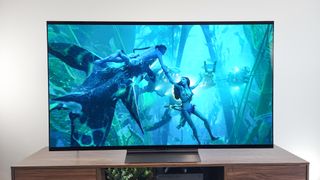
The only other distinguishing visual element on the front is the IR emitter on the bottom-center edge. Reach under it to find a physical button for powering the set on or off, adjusting the volume and moving through channels.
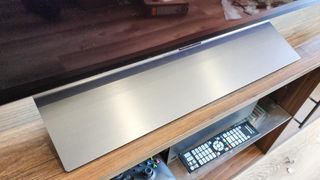
The rest of the set’s depth (1.8 inches in total) comes by way of the control box on the attractively mottled dark gray rear panel. There are also 300x200mm VESA holes here for mounting the TV on the wall.
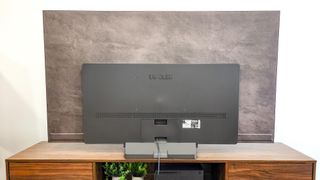
Should you prefer to place it on an entertainment center, the included stand is a fine option. Just screw the pieces together, then screw the backplate portion to the TV itself. Though the back is matte, gray plastic, the brushed-metal foot in front matches the screen’s aesthetic, and its sturdy construction and central positioning allows for plenty of peace of mind, positioning options, and unobtrusive soundbar placement.
LG C4 OLED review: Ports
The power cable is permanently attached to the back center of the TV and can be routed straight down through the stand, with a snap-on panel keeping things looking clean. All of the C4’s ports are conveniently located on the left edge of the control box. These include an IR emitter, coaxial cable, RS-232C service, S/PDIF optical audio out, Ethernet, three USB, and four HDMI (with the second port supporting eARC for connecting an external soundbar).
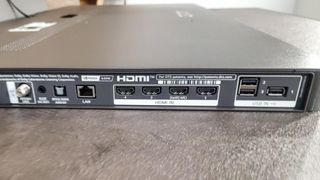
All of the HDMI ports support the newer and more powerful HDMI 2.1 standard, which enables such features as 4K at 120Hz, Variable Refresh Rate (VRR), Auto Low-Latency Mode (ALLM), and Quick Media Switching (QMS). Some brands don’t max out the 2.1 ports even on their highest-end TVs, reasoning that there’s not much to connect besides an Xbox and a PlayStation 5, but it’s nice to see that LG has future-proofed the C4 this way regardless.
LG C4 OLED review: How we test
We follow a standard testing protocol for every TV we review at Tom’s Guide. Our benchmarks include a series of technical and subject tests designed to rate the set’s performance. For our technical tests, we use an X-Rite i1 Pro spectrophotometer, a SpectraCal VideoForge Pro pattern generator, and Portrait Displays’ Calman TV-calibration software to take measurements. We also use a Leo Bodner 4K Input Lag Tester for determining the TV’s gaming prowess.
Subjective tests vary based on the reviewer, but usually feature anecdotes from a diverse selection of movies, TV shows, and other content reflecting the types of things you may actually want to watch on the TV. For a more detailed look at what we do and how we do it, check out our “How we test TVs” page.
LG C4 OLED review: Performance
With their vibrant colors and perfect black levels, OLED TVs are widely regarded as some of the best-looking screens on the market, and LG arguably creates some of the best TVs with this technology. The α9 AI Processor 4K Gen7 processor and support for a variety of major picture technologies such as HDR10 (but not HDR10+), HLG, and Dolby Vision further supercharge the viewing experience with the C4 OLED.
Where sheer image quality is concerned, the C4 OLED looks terrific, and its OLED panel ensures you can sit anywhere in your room and still feel like you’re sitting in the front row.
We were thoroughly impressed by its picture. Whether we were watching the pink-freebasing Barbie, the magically saturated The Super Mario Bros. Movie, the magically aquatic Avatar: The Way of Water, or even something that pushes real-life hues to their limits such as the Netflix series Is It Cake?, each movie and show impressed with its contrast and visual richness.
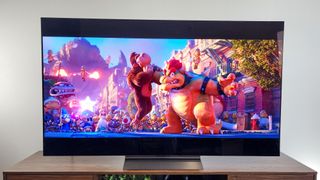
The C4 OLED had no trouble with movies with more subdued color palettes, either. Christopher Nolan’s epic Oppenheimer was a piercing study in contrasts, with its lengthy black-and-white scenes and realistic color sections rendered equally effectively. The action and sprawling cinematography of Mission: Impossible—Dead Reckoning didn’t disappoint, either, with the 120Hz panel keeping everything looking smooth.
Where sheer image quality is concerned, the C4 OLED looks terrific, and its OLED panel ensures you can sit anywhere in your room and still feel like you’re sitting in the front row.
| Row 0 - Cell 0 | LG OLED Evo C4 | LG OLED evo C3 | Samsung S95C |
| SDR Brightness (10%, in nits) | 296 | 237 | 249 |
| Delta-E (lower is better) | 1.8201 | 1.3908 | 1.4542 |
| Rec. 709 Gamut Coverage | 98.9136 | 99.0904 | 98.7273 |
| HDR Brightness (10%, in nits) | 1049 | 820 | 1369 |
| UHDA-P3 Gamut Coverage | 98.15 | 98.98 | 99.09 |
| Rec. 2020 Gamut Coverage | 72.27 | 73.77 | 74.47 |
| Input Lag (ms) | 12.9/9.2 (Boost) | 12.9/9.1 (Boost) | 9.2 |
Our technical tests showed that our eyes were not playing tricks on us. Although the C4 isn’t the leader of every category of picture quality — the Samsung S95C QD-OLED betters it on a couple of key metrics — it still is a marked step up from its predecessor, the LG C3 OLED, as far as brightness is concerned.
The C4 OLED sets a new standard for LG’s midrange C-Series with its 1,049 nits of peak brightness in HDR and 296 in SDR (in both cases, measured in a 10% window in Filmmaker Mode). The C3 OLED’s 237 and 820 nits, respectively, just don’t compare, though even the C4 can’t match the S95C (1,369 nits) in this regard.
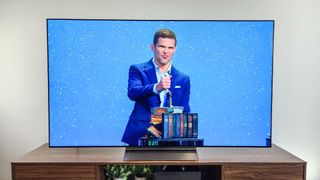
Much the same was true of color handling, with the C4’s Delta-E (a number representing the difference in color between the source and what appears on the screen, with lower values always better) an impressively low 1.8201 that isn’t quite as good as what we saw from the S95C. And though the C4 covers large swaths of the Rec. 709 (SDR) and the UHDA-P3 and Rec. 2020 (HDR) color gamuts (98.9136%, 72.27% and 98.15%, respectively), Sony and Samsung both do just a bit better.
These differences, however, are minor and do little to prevent the C4’s picture from looking good and will only truly matter to those who want it to have the highest brightness and most accurate colors possible.
LG C4 OLED review: Audio
Considering how good the C4’s picture is, you would think that sound would get as much attention. But the C4’s audio is, at best, passable.
The TV doesn’t get super loud, and it rumbles a bit even at lower volume levels that prevent your ears from experiencing the same crystalline clarity your eyes do. It’s not that movies, TV shows, or our test music tracks (which include The Knife’s bass-predominant “Silent Shout” and a soprano solo that crests to a high B-flat) sounded bad. But even with Dolby Atmos support, the downward-firing 40W speakers don’t give you the same pristine quality you get from, say, higher-end Sony sets that use the company’s unique “screen-as-speaker” strategy.
Though the C4’s audio suffices for general viewing, if you’re any kind of an audiophile, you will want to add one of our best soundbars to your entertainment setup.
LG C4 OLED review: Gaming
LG’s commitment to gaming performance and features remains as firm with the C4 as was the case with the previous generation. In our tests, the C4 measured a fairly low 12.9ms of input lag in Game Mode with the default settings, but this dropped to an excellent 9.2ms when we activated the Game Optimizer’s Boost feature. This keeps LG’s higher-end TVs in direct competition with most of Samsung’s TVs, including the S95C, for the tightest gaming performance out there.
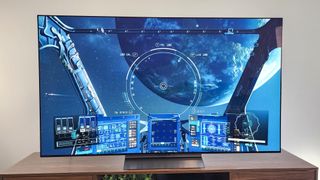
Another nice feature for gamers is the Game Dashboard. Raising it while playing a title lets you turn Dark Room Mode on or off, activate or deactivate Multi View, open the Game Optimizer for tweaking gaming-specific settings, or visit the set’s overall Settings panel. You can also see at a glance the game’s frame rate, VRR status, black stabilizer level, and whether Low Latency is activated, or you change to a different gaming picture mode. The Dashboard is a bit on the chunky side, taking up a bit more than a quarter of the screen, but its functionality is top-notch.
To reduce screen tearing, the C4 supports AMD’s FreeSync Premium technology and is rated G-Sync Compatible for Nvidia’s system. The native 120Hz panel is ideal for gaming — in our tests, Starfield was thoroughly satisfying to play, with fluid action and its outer-space and planetside graphics beautifully rendered — and if you connect a PC that supports a 144Hz refresh rate, the C4 can match that, too. This is very handy if you plan on using the C4 OLED as both your main TV and gaming monitor.
LG C4 OLED review: Smart features
LG’s webOS has been one of the better implementations of smart TV software for a while now, and the newest version (24) is only an improvement.
The on-screen interface remains well organized and navigation friendly, but now it’s even more streamlined and you can add up to 10 user profiles. At the top of the home screen is a large, rotating ad carousel. A row below that contains the updated stack of Quick Cards, which organize the TV’s features into six categories. Home Office, Games, and Music, are self-explanatory. Home Hub is used for connecting to LG’s ThinQ smart home ecosystem. Sports now lets you follow and get a wealth of information about a specific team and players, including scores, schedules and videos. Finally, Accessibility simplifies making adjustments if you have trouble seeing or hearing, learning the remote’s features, or for accessing tips or an AI help chatbot.
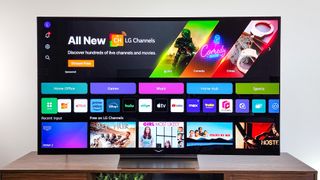
Then there’s the app row, which is prepopulated with all the most popular choices and which you can customize by adding, subtracting, or re-ordering. Finally come various rows highlighting content from the LG Channels TV aggregator, new titles from streaming services, and so on. As usual, the farther down the home screen you go, the less useful your choices become, but the cleanness and clarity of the webOS layout has always been a major selling point.
Should you still not be able to find anything to watch, you can cast from another device. Apple AirPlay 2 is still supported for this purpose, but there’s a major (and welcome) new addition in Chromecast as well.
Over-the-air broadcasts are trickier. Whereas previous years’ LG TVs were equipped with an ATSC 3.0 tuner, because of a patent dispute, all of LG’s 2024 TVs will include only an ATSC 1.0 tuner incapable of play over-the-air 4K. This was announced a while ago, but is still a step backward, and something you’ll want to pay attention to if you care about getting the most out of broadcast TV.
LG OLED evo C4 review: Remote
The C4 comes with LG’s Magic Remote, which has received no changes from prior incarnations. Not that it needed them. Its controls are well laid out from the Power button and number pad at the top to the six shortcut keys for Netflix, Amazon Prime Video, Disney+, LG Channels, Sling, and Alexa on the bottom. You may operate it as a traditional remote, by using the five-way directional pad (with a scroll wheel at the center), or as something like a mouse using the on-screen pointer that appears when you wave the device.
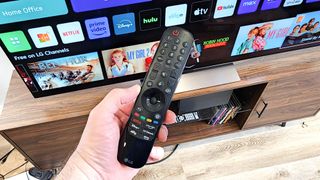
Remotes have been trending smaller and more rectangular of late, so the Magic Remote’s bigger size and more classically ergonomic feel make it stand out. It’s easy and comfortable to use, even if (like me) you could do without the jittery pointer on screen.
LG C4 OLED review: Verdict
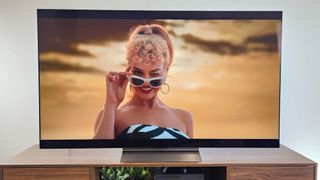
Taken on its own, the LG C4 OLED is an outstanding TV, and in everything from its design and remote to its smart OS and gaming features bears all the hallmarks of a product whose company was intent on getting all the details just right. But its higher-than-average price, performance numbers that aren’t quite class leading, and lack of killer sound and an ATSC 3.0 tuner keep it short of greatness.
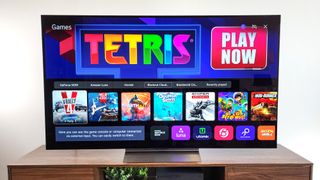
If you want to save some money, the still-available LG C3 OLED carries a lot of the same features and only a few minor performance setbacks for quite a bit less. And the Samsung S95C uses a more advanced QD-OLED panel for better brightness and color saturation.
Not all of these things will matter to everyone, and if you can wait a few months for the price of the LG C4 OLED to drop — the 65-inch LG C3 OLED went from $2,599 to $1,499, for example — then its few caveats could be forgiven. But the LG C4 OLED falls just short of earning its current high price.
Matthew Murray is the head of testing for Future, coordinating and conducting product testing at Tom’s Guide and other Future publications. He has previously covered technology and performance arts for multiple publications, edited numerous books, and worked as a theatre critic for more than 16 years.
-
stljrs Another website mentioned the picture becoming green moving off center. Did you observe that?Reply
When looking at displays, the loop video doesn't really work to be able to observe that. Those videos are fast moving and have ultra vibrant colors and no skin tones where you'd see it watching shows every day.
